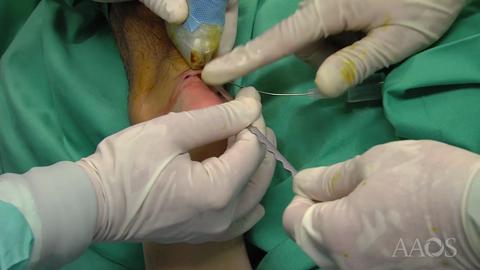Ultrasound-guided Ultraminimally Invasive Surgical Techniques for Non-insertional Achilles Tendinopathy
Introduction: Achilles tendon disorders can be insertional or non-insertional. Tendinopathy affects 10% of recreational runners. It accounts for 5 to 15% of all running injuries and forces 5% of professional athletes to end their careers. Ultrasound screening has revealed degeneration of the body of the Achilles tendon in up to 30% of asymptomatic individuals. Scientific evidence on managing tendinopathy is limited, and the most appropriate treatment option remains unclear.Forms of Treatment: Current approaches for the management of non-insertional Achilles tendinopathy can be either surgical or conservative. Most patients can be treated conservatively. However, 25% of patients have persistent symptoms that may require surgery three to six months after conservative management is complete. Surgical procedures can be open, mini-open, endoscopic, and minimally invasive.Surgical Techniques: Ultrasound-guided techniques range from mini-open surgery to percutaneous approaches. In the coming years, they are expected to become ultraminimally invasive. The aim of this video is to illustrate, in patients and cadavers, how to perform most of the described surgical procedures for non insertional tendinopathy and Achilles paratendinopathy with ultrasound-guided ultraminimally invasive techniques. We illustrate these procedures and evaluate their effectiveness and safety. The procedures illustrated include gastrocnemius recession, high-volume injections, multiple percutaneous longitudinal tenotomy, scraping procedures outside the ventral part of the tendon, plantaris tendon stripping, brisement or volume adhesiotomy of the paratenon, and paratenon mechanical stripping.Rehabilitation Protocol: These procedures can be perform on outpatient regiment, under local anesthesia, without stitches and with a minimum aggression. Active dorsiflexion and plantar flexion of the ankle is encouraged immediately after surgery. Patients are allowed to walk with elbow crutches and an orthotic boot, with partial weight bearing on the first or second day after surgery. Full weight bearing is allowed after three to seven days, depending on pain and discomfort. The boot can be removed after two to four weeks, and the patient can progress to a regular shoe and start physiotherapy and sports.Discussions/Conclusions: A) Several surgical procedures have been described for non-insertional Achilles tendinopathy; however, the best option remains controversial. Large randomized controlled trials are necessary to evaluate available techniques and to design a treatment algorithm.B) Many of the current surgical procedures for non-insertional Achilles tendinopathy can be optimized with ultrasound. Since they can be performed on an outpatient basis under local anesthesia and without a tourniquet, complications and contraindications are minimized in patients with vascular problems or diabetes.C) Ultrasound-guided, ultraminimally invasive surgery is an emerging technology that gives the surgeon direct control of the main structures. As it causes minimal pain and swelling, recovery is quicker. However, the learning curve is steep, because the surgeon has to perfect the technique with cadavers and become competent in the use of ultrasound. D) We think ultrasound-guided procedures will become the gold standard for most indications in the coming years.
